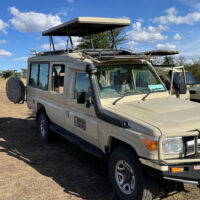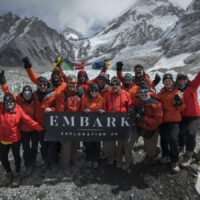Tipping and Currency Issues
on Kilimanjaro
and in Tanzania
10.08.2016

Hello, Travelers! We are back with our series of informational messages to help you prepare as you draw closer to your date of departure.
Other topics include:
- Passports & Visas
- Personal Hygiene
- Shots and Vaccinations
- Gear Lists, Packing and Baggage Weight Restrictions
This post is all about the ever-popular topic of tipping.
Tipping is a way of life in the guiding community of Kilimanjaro, and the porter or guide’s personal income from that source often comprises as much as 50% of his regular pay. Everyone worries excessively about how much to tip and how to present it. Tipping need not be a stressful activity, though it usually turns out to be a subject of considerable discussion during the climb, so let’s get rid of it now so we can all relax and enjoy the view(s).
How To Do It
There are many ways to approach tipping, but I have found that everyone enjoys a little ceremony at the end of the trip, usually on the last day you will spend together with your guides, porters and camp staff. It is always accompanied by ceremony, singing and dancing…after all, this is East Africa.
With large groups like yours, a method that I have found that works well is for you, as a group, to select one or two group members to organize the process the night before, and then present a “group tip” to each of the support staff, based on the mysterious and arcane hierarchy of Kilimanjaro workers.
Who Gets What?
Guides earn the most, so their tip is the largest; not surprisingly, cooks make almost as much — after all, a happy group travels on happy stomachs. Next come the porters, based on seniority; cook helpers are next, and then camp helpers.
A pretty reliable tipping guideline, regardless of the recipient’s job, is the equivalent of one extra day’s pay for every seven days worked, or roughly 15%. This is the rate generally recommended by The Lonely Planet as well as several other sources. Although no one pins it down very precisely, I have used that formula numerous times and have always been greeted by broad smiles and vigorous handshakes, so I think it must be pretty close.
On the last night, at Mwerko camp, the tip organizer will collect from all participants the anticipated pro-rated share of the group tip. Your Head Guide will bring small manila envelopes for each tip, upon which the tip organizer will write each recipient’s name, working from a personnel manifest the Head Guide will provide. The guys seem to enjoy receiving US dollars, so each tip is calculated based on the daily earnings for each job category, and sealed in the envelope. Two people, working in the mess tent after dinner, can accomplish this task in about an hour.
The Ceremony
The next day, at Mwerko Gate, you will all gather for lunch. At some point, the guys will gather for songs of thanks and of good-bye, and dancing is liable to break out. Short speeches of thanks and gratitude may follow, and as circumstances allow, the tip organizer, usually assisted by the head guide, will begin to present the tip envelopes to each man. Each recipient will then likely circle the group, greeting and thanking everyone. Expect hugs and beware of tears.
Above and Beyond
The above will take care of the group obligation. However, during these trips you will get acquainted with these guys. They will teach you some words in their language and take delight in your efforts to repeat them and use them in conversation. They will do you favors, and help you along the way. You will develop favorites, and trust me, by the end of the trip you will want to express your personal thanks to some of them.
It is perfectly acceptable to express your thanks with an individual tip to those you have come to appreciate especially, and immediately after presentation of the group tip is a good time to do it. It can be done openly and directly, with your own personal thanks in the form of a handshake or a hug.
It is also common to gift the crew with items of clothing or equipment that you no longer need or don’t wish to carry home. Depending on the item, they may keep it and use it, or you may see it on E-Bay the next day. Don’t take offense if that happens…either way, they benefit, and that is the whole point of the exercise.
Adding It All Up
For a group of your size, you will have a head guide and several assistant guides. The guide will speak English, the assistants may speak some English, the porters are not likely to speak much English at all. There will be a cook, one or more assistant cooks, and kitchen helpers and servers. There will be porters to carry your duffle bags, and porters to carry all the camp and kitchen gear. It is not unusual for a large group to move up the mountain with as many as 60 – 70 support staff.
It should be anticipated, therefore, that each participant’s share of the group tip will be about $400 to $450. Plan accordingly to have that amount available in US dollars, in relatively small bills (more 10’s and 20’s, fewer 50’s or 100’s,) which will simplify the tip organizer’s task of making up the individual tips. Additional individual tips or gifts, if any, will be entirely at your discretion.
Getting Cash
Do you need to carry all that cash from home? No. There are ATM’s readily available in Moshi, Dar Es Salaam and Zanzibar, and you will receive the best exchange rate through a bank machine — but it will be dispensed in Tanzanian Shillings. Fees will be incurred for the use of the ATM, and fees are charged for the exchange of shillings to dollars or vice-versa.
Another option for acquiring cash or making exchanges without incurring fees may be to use a credit card that charges no foreign currency fees, such as Capital One Visa or some of the American Express cards, but these transactions must necessarily be done at a traditional bank, many of which are to be found in Moshi. Street exchanges deal only in cash.
(TZS) currently (October 2016) valued at about TZS .00046 /USD1.00, so:
- $1.00 = TZS 2182
- $10.00 = TZS 21,821
- $100.00 = TZS 218,211
This website will give you the up-to-date conversion rate.
Carrying huge wads of TZS notes can be burdensome, but fortunately, US currency is readily accepted in most places. Change, however, will be given in TZS, and the exchange rate may not be as favorable as in ATM’s or at banks. It is therefore a good idea to carry both currencies, using USD for larger purchases, and TZS for smaller items or tips. ATM’s are not readily found in rural areas, or anywhere on Kilimanjaro itself, nor are credit cards readily accepted outside of the larger towns.
Carrying Cash
A careful traveler always considers common sense and security while carrying cash in unfamiliar surroundings. Consider carrying your money in a cloth belt around your waist, or in a passport wallet hung around your neck beneath your clothes. Be mindful of your surroundings when extracting cash in public, and be discreet about doing it. Most of the places you will visit on this trip are generally safe, but security risks can be encountered anywhere. Travel in pairs whenever possible, and avoid isolated areas after dark.
I hope this brief description of an often stressful subject will help to de-mystify a topic that sometimes occupies more of our attention than is necessarily warranted. The process of fairly and adequately compensating those that help us do what we love to do is actually satisfying, and should be approached with pleasant anticipation rather than trepidation.
The singing and dancing that typically accompany the disbanding of a group like this is a joy to experience. Keep your smart phone video handy, and enjoy the show.



